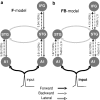Dynamic causal modelling for EEG and MEG
- PMID: 19003479
- PMCID: PMC2427062
- DOI: 10.1007/s11571-008-9038-0
Dynamic causal modelling for EEG and MEG
Abstract
Dynamic Causal Modelling (DCM) is an approach first introduced for the analysis of functional magnetic resonance imaging (fMRI) to quantify effective connectivity between brain areas. Recently, this framework has been extended and established in the magneto/encephalography (M/EEG) domain. DCM for M/EEG entails the inversion a full spatiotemporal model of evoked responses, over multiple conditions. This model rests on a biophysical and neurobiological generative model for electrophysiological data. A generative model is a prescription of how data are generated. The inversion of a DCM provides conditional densities on the model parameters and, indeed on the model itself. These densities enable one to answer key questions about the underlying system. A DCM comprises two parts; one part describes the dynamics within and among neuronal sources, and the second describes how source dynamics generate data in the sensors, using the lead-field. The parameters of this spatiotemporal model are estimated using a single (iterative) Bayesian procedure. In this paper, we will motivate and describe the current DCM framework. Two examples show how the approach can be applied to M/EEG experiments.
Figures







Similar articles
-
Bayesian fusion and multimodal DCM for EEG and fMRI.Neuroimage. 2020 May 1;211:116595. doi: 10.1016/j.neuroimage.2020.116595. Epub 2020 Feb 3. Neuroimage. 2020. PMID: 32027965
-
Dynamic causal modelling of EEG and fMRI to characterize network architectures in a simple motor task.Neuroimage. 2016 Jan 1;124(Pt A):498-508. doi: 10.1016/j.neuroimage.2015.08.052. Epub 2015 Aug 31. Neuroimage. 2016. PMID: 26334836
-
Dynamic causal modelling of evoked responses: the role of intrinsic connections.Neuroimage. 2007 Jun;36(2):332-45. doi: 10.1016/j.neuroimage.2007.02.046. Epub 2007 Mar 13. Neuroimage. 2007. PMID: 17462916
-
Dynamic causal modelling: a critical review of the biophysical and statistical foundations.Neuroimage. 2011 Sep 15;58(2):312-22. doi: 10.1016/j.neuroimage.2009.11.062. Epub 2009 Dec 1. Neuroimage. 2011. PMID: 19961941 Review.
-
Dynamic causal modeling for EEG and MEG.Hum Brain Mapp. 2009 Jun;30(6):1866-76. doi: 10.1002/hbm.20775. Hum Brain Mapp. 2009. PMID: 19360734 Free PMC article. Review.
Cited by
-
Adjudicating Between Local and Global Architectures of Predictive Processing in the Subcortical Auditory Pathway.Front Neural Circuits. 2021 Mar 12;15:644743. doi: 10.3389/fncir.2021.644743. eCollection 2021. Front Neural Circuits. 2021. PMID: 33776657 Free PMC article. Review.
-
Separating Uncertainty from Surprise in Auditory Processing with Neurocomputational Models: Implications for Music Perception.J Neurosci. 2022 Jul 20;42(29):5657-5659. doi: 10.1523/JNEUROSCI.0594-22.2022. J Neurosci. 2022. PMID: 35858813 Free PMC article. No abstract available.
-
A realistic neural mass model of the cortex with laminar-specific connections and synaptic plasticity - evaluation with auditory habituation.PLoS One. 2013 Oct 30;8(10):e77876. doi: 10.1371/journal.pone.0077876. eCollection 2013. PLoS One. 2013. PMID: 24205009 Free PMC article.
-
Model-Based Approaches to Investigating Mismatch Responses in Schizophrenia.Clin EEG Neurosci. 2025 Jan;56(1):8-21. doi: 10.1177/15500594241253910. Epub 2024 May 15. Clin EEG Neurosci. 2025. PMID: 38751125 Free PMC article. Review.
-
Brain Functional Correlates of Resting Hypnosis and Hypnotizability: A Review.Brain Sci. 2024 Jan 24;14(2):115. doi: 10.3390/brainsci14020115. Brain Sci. 2024. PMID: 38391691 Free PMC article. Review.
References
-
- Baillet S, Mosher JC, Leahy RM. Electromagnetic brain mapping. IEEE Signal Process Mag. 2001;18:14–30. doi: 10.1109/79.962275. - DOI
-
- Beal MJ (2003) Variational algorithms for approximate Bayesian inference. University College London
Grants and funding
LinkOut - more resources
Full Text Sources

